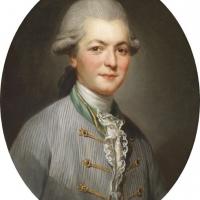Joseph Ducreux
Charles Joseph De Pallu
$480.00
Joseph Ducreux
Joseph Ducreux (1735-1802)
Joseph, Baron Ducreux (26 June 1735 – 24 July 1802) was a French noble, portrait painter, pastelist, miniaturist, and engraver, who was a successful portraitist at the court of Louis XVI of France, and resumed his career after the French Revolution. He was made a baron and premier peintre de la reine (First Painter to the Queen), and drew the last portrait ever made of Louis XVI before the king’s execution. His less formal portraits reflect his fascination with physiognomy and show an interest in expanding the range of facial expressions beyond those of official portraiture.
Ducreux specialized in portrait painting, and his early portraits were done in pastel, and include those done of the connoisseurs Pierre-Jean Mariette, the Comte de Caylus and Ange-Laurent de la Live de July. These works may have been copies after De La Tour. From 1760 onward, Ducreux kept a list of his works, but throughout his lifetime, he rarely signed his paintings. Thus, many of his works remain erroneously attributed to other artists.
Other portraits by Ducreux include those done of Pierre Choderlos de Laclos and Maria Theresa of Austria, as well as those mentioned above of Louis XVI and Marie Antoinette. Ducreux also made several well-known self-portraits in the 1780s and 1790s, including one (now in the collection of the Getty Center in Los Angeles; c. 1783, right) in which he painted himself in the middle of a large yawn. In another, Portrait de l'artiste sous les traits d'un moqueur (c. 1793, Louvre; above right), the artist guffaws and points at the viewer.
As evidenced by these self-portraits, Ducreux attempted to break free from the constraints of traditional portraiture. Interested in physiognomy, the belief that the study and judgment of a person's outer appearance, primarily the face, reflects their character or personality, he attempted to capture the personality of his subjects, as well as his own, through his warm and individualistic works. Le Discret (ca. 1790), for example, is the portrait of a man asking for silence. His expression is timorous, his finger is pressed against his mouth in alarm as he silently demands discretion or prudence.
In this, these portraits recall the tronies of Dutch Golden Age painting, and the "character heads" of his contemporary the Austrian sculptor Franz Xaver Messerschmidt (1736–1783), some of whose busts were self-portraits with extreme expressions.
Ducreux's self-portrait Portrait de l'artiste sous les traits d'un moqueur (shown below) has become subject to internet popularity as part of an internet meme. In the meme, rap and pop song lyrics, common internet phrases, and similar tropes are paraphrased in verbose, stilted, or faux-archaic English and overlaid on top of the portrait to create an image macro.




